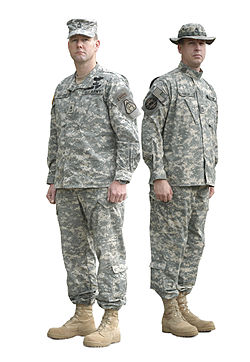
Multi-scale camouflage is a type of military camouflage combining patterns at two or more scales, often (though not necessarily) with a digital camouflage pattern created with computer assistance. The function is to provide camouflage over a range of distances, or equivalently over a range of scales (scale-invariant camouflage), in the manner of fractals, so some approaches are called fractal camouflage. Not all multiscale patterns are composed of rectangular pixels, even if they were designed using a computer. Further, not all pixellated patterns work at different scales, so being pixellated or digital does not of itself guarantee improved performance.
Contents
- Principle
- Scale invariance
- Design trade-offs
- History
- Interwar development in Europe
- German WWII experiments
- Soviet WWII experiments
- 1976 research by Timothy O'Neill
- 2000s fractal-like digital patterns
- Notes
- References
The first standardized pattern to be issued was the single-scale Italian telo mimetico . The root of the modern multi-scale camouflage patterns can be traced back to 1930s experiments in Europe for the German and Soviet armies. This was followed by the Canadian development of the Canadian Disruptive Pattern (CADPAT), first issued in 2002, and then with US work which created the Marine pattern (MARPAT), launched between 2002 and 2004.







